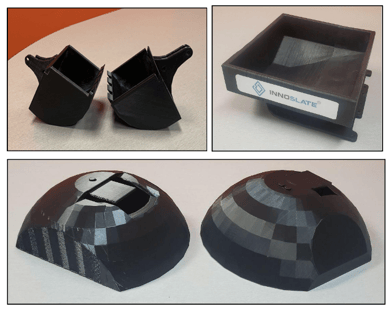SPEC Innovations Attends NDIA Conference
SPEC Innovations President, Dr. Steven Dam, and Systems Engineers, Michael Campbell and Andy Tapia, just got back from representing SPEC Innovations...

Not up for reading? Watch the recording!
SPEC Innovations is the developer of Innoslate, a cloud-based MBSE tool designed to support the system engineering lifecycle from concept to disposal. Our goal is to release user-driven updates to our tool, incorporating feedback and experimenting with new features. SPEC engineers used Innoslate to develop SPECTER, a lunar rover showcasing our commitment to showcasing our ability to support the digital thread.
Before delving into our SPECTER project, let's clarify the term "digital thread." According to the fifth edition of the INCOSE System Engineering Handbook, a digital thread is a “set of interconnected cross-discipline model data facilitating the controlled interplay of digital artifacts throughout a system's lifecycle.” In simpler terms, it is a digital record of all engineering data driving decisions throughout a system's lifecycle, encompassing diagrams, models, documents, spreadsheets, and more.
Our journey with SPECTER began when we learned about NASA's Break the Ice Challenge in the summer of 2021. Although we were late to submit a proposal, we recognized the opportunity to showcase Innoslate's ability to support the digital thread. Inspired by the challenge, we set a goal to create a lunar rover prototype system using a complete digital thread, focusing on the physical boundaries of the lunar rover.
NASA's Challenge sought innovative solutions and technologies to support lunar missions and sustained human presence on the moon. In our case, we focused on phase one, addressing challenges related to excavating lunar regolith, maximizing water delivery, minimizing equipment, and reducing power consumption.
To align our project with established system engineering practices, we used the System Engineering V-Model. Our design and analysis phase seamlessly transitioned into integration and verification, with program management aspects woven throughout the process.
Our digital thread implementation began with the creation of a Project Management Plan (PMP) and a Statement of Work (SOW). The PMP, a living document in our database, outlined project scope, technical execution, schedule, and budget. The SOW goes deeper into the technical aspects, breaking the project into research, design, build, test, and demonstration phases.
We generated a schedule using the timeline diagram to track progress, milestones, and deadlines. The Gantt chart, derived from the SOW action diagram, depicted task dependencies, offering a visual representation of the critical path.
Initiating the lunar rover project involved creating a comprehensive set of documents and diagrams using Innoslate's features. Our research included extracting mission requirements from NASA's documentation and incorporating quality checks to ensure clarity and adherence to standards.
We used an Analytical Hierarchy Process (AHP) to select the Leo Rover as the base design. The process involved creating a bill of materials (BOM), cost breakdown structure (CBS), and utilizing ANSYS CAD tools to modify the Leo Rover design. The 3D printing and assembly phases resulted in the creation of SPECTER, combining the Leo Rover with excavation and storage subsystems.

The testing phase utilized Innoslate's Test Center, ANSYS, and other tools to verify and validate SPECTER's functionality. Test cases were aligned with requirements, ensuring end-to-end traceability. Further analyses included structural, environmental, and performance assessments.
Considering the lunar environment, we conducted analyses to estimate the time required to achieve the mission goal of extracting 10,000 kilograms of water. Performance parameters, including total landed mass, power consumption, and water mass delivered, were meticulously calculated and validated.
Our analyses indicated that the total landed mass on the moon, including supporting equipment, needed to be carefully managed to achieve the mission goals efficiently. Addressing risks related to extreme lunar conditions, we designed SPECTER to withstand sub-zero temperatures, reduced gravity, and potential hazards like lunar dust.
The SPECTER Lunar Rover project exemplifies the seamless integration of a digital thread into the system engineering lifecycle. From inception to testing, Innoslate's features and capabilities played a crucial role in ensuring a systematic and efficient development process.
Have questions about model-based systems engineering or requirements management? Talk to an expert and see how Innoslate can streamline your projects from start to finish.
%20(200%20%C3%97%20100%20px)%20(800%20%C3%97%20400%20px)%20(18).png)
SPEC Innovations President, Dr. Steven Dam, and Systems Engineers, Michael Campbell and Andy Tapia, just got back from representing SPEC Innovations...

Not up for the read? Watch the recording of the webinar!
.png)
Manassas, VA; 7-18-2023: SPEC Innovations, the developers of the first cloud-native, model-based systems engineering and requirements management...